
Modern American rock music would have been a whole lot different without the rundown dive mecca CBGB’s, a beat-up former flophouse bar that made stars out of young musicians and helped shape the musical edge of downtown Manhattan. Owner Hilly Kristal may have initially envisioned a place for ‘Country Blue Grass and Blues’, but the music spawned by this little hole in the wall would define the contours of American punk and new wave.
The Ramones, Blondie, the Talking Heads and hundreds of others bands would never have been the same without this dank little club with the most notorious bathroom stalls in New York. Tune in to hear a tale of the club’s rather inauspicious start and find out why, even as a venerated music icon, it was forced to close its doors.
| link | Listen to the podcast |
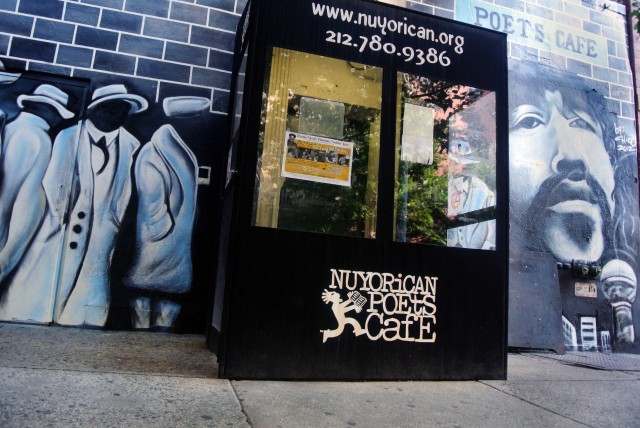
New York City in the 1970s bore witness to a growing number of mostly self-taught artists actively working to avoid the politics and aesthetics of the existing art world. Events like the Summer of Love and the Woodstock Music and Art Fair had launched the counterculture movement of the ‘60s into the mainstream and gave way to a “New Wave” in art and culture, typified by bands like Blondie and the Talking Heads. Countering the trajectory of pop-culture, some subscribed to the “No Wave” movement and renounced the industry surrounding the arts. Elsewhere in the world, the primitive aesthetics of German neo-expressionist painting and the Italian transavantgarde mirrored this disavowal of established norms.
Founded by a group of independent poets in 1973, the Nuyorican Poets Cafe grew out of a similar autonomous sentiment. The Cafe was formed by a group of mostly unpublished writers and poets in the living room of Puerto Rican born writer Miguel Algarin’s Lower East Side apartment. It served as a creative and cultural center for the neighborhood and aligned itself with the burgeoning “Loisaida” movement which called attention to the unmistakeable Puerto Rican identity of the area. The Loisaida movement aimed to overcome the ostracism of Puerto Rican immigrants living in New York and the writing of people like Algarin was at the core of the project. Other notable founders of the Cafe include writer Miguel Piñero who, while incarcerated, wrote Short Eyes, an award-winning play about life in prison, and Ntozake Shange, known for her writing on themes of race and feminism.
In 1975 the Cafe moved to a former Irish pub on East 6th street and in 1981, it took dominion over a former tenement building. New York City had suffered extreme economic difficulty at the end of the previous decade, leaving the majority of Lower East Side tenements abandoned or under government seizure. The Cafe co-opted one such building, as did similar groups of “Outsider” artists like the art collective that opened ABC No Rio on Rivington Street—an exhibition space whose egalitarian curatorial policy was “first-come, first-hung”.
Today, the Nuyorican Poets Cafe still operates out of the same space it has occupied since 1981 and offers programming in music, poetry, and literature.
– Sam Ashman
| link | Nuyorican Poets Cafe Website |
| wiki | Wikipedia |
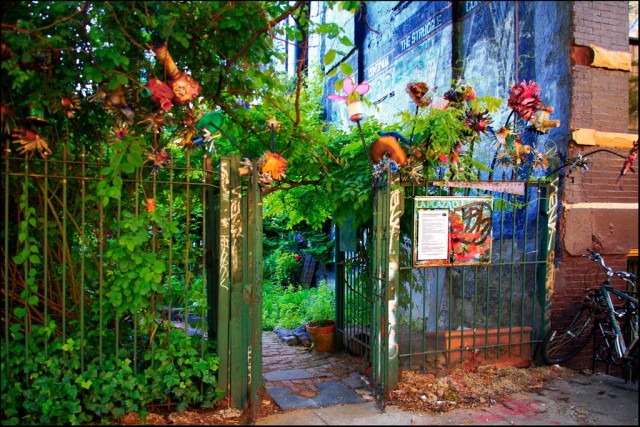
La Plaza Cultural was founded in 1976 by local residents and greening activists who took over what were then a series of vacant city lots piled high with rubble and trash. In an effort to improve the neighborhood during a downward trend of arson, drugs, and abandonment common in that era, members of the Latino group CHARAS cleared out truckloads of refuse. Working with architect Buckminster Fuller, they built a geodesic dome in the open “plaza” and began staging cultural events. Green Guerillas pioneer Liz Christy seeded the turf with “seed bombs” and planted towering weeping willows and linden trees. Artist Gordon Matta-Clark helped construct La Plaza’s amphitheater using railroad ties and materials reclaimed from abandoned buildings. Later, block residents tilled the western portion of the space and planted vegetables, flowers and fruit trees. During the 1980s, the garden came under attack by developers seeking to build on the space. After numerous court battles, La Plaza was finally preserved in 2002 as part of the terms of a legal settlement. In 2003, La Plaza was renamed in memory of Armando Perez, a CHARAS founder and former District Leader of the Lower East Side who was killed in 1999.
via Wikipedia
| internal | gDoc TBC |
| internal | Wikipedia |
| internal | Plaza website |
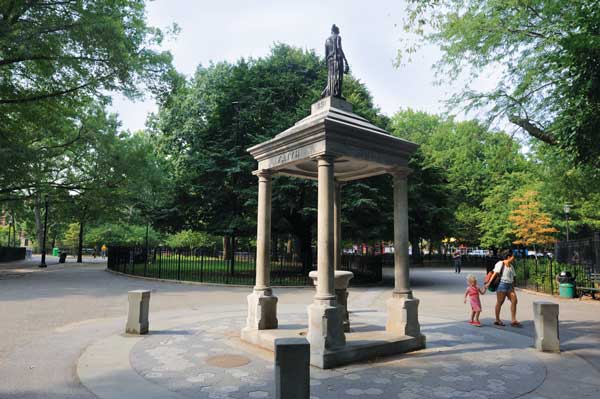
Dating to 1888, this neo-classical fountain was the gift of the wealthy San Francisco dentist, businessman, and temperance crusader Henry D. Cogswell (1820–1900).
Cogswell was born in Tolland, Connecticut in 1820, the son of an architect and builder. News of the California Gold Rush of 1849 lured Cogswell to San Francisco. There his prosperous dental practice and real estate investments permitted him to retire in 1856 with a fortune estimated at $2,000,000. He engaged himself in public philanthropy, founding the Cogswell Polytechnic Institute, and helping to advance the anti-alcohol or “temperance” movement. Often, his charitable acts were tinged with self-promotion, and in an effort to embellish his humble origins, he adopted the coat of arms of Humphrey Cogswell, a 15th-century English lord, from whom Henry falsely claimed his lineage.
Cogswell’s most lasting legacy was the 50 monuments he sponsored nationwide between 1878 and the 1890s. Most were versions of the temperance fountain. Several of the fountains, such as those in Washington, D. C., Boston Common, and in Tompkins Square Park, were covered by a stone canopy or baldachin supported by four Doric columns. As can be seen here, the four stone entablatures were emblazoned with the words Faith, Hope, Charity, and Temperance.
The erection of the Temperance Fountain in Tompkins Square Park resulted from Cogswell’s affiliation with the Moderation Society, which was formed in 1877 to address health conditions on the Lower East Side, and to distribute free ice-water fountains to encourage citizens to drink water instead of alcoholic beverages. Cogswell served as the group’s honorary president in 1890, and the collaboration produced another temperance fountain at the New York City main post office at 34th Street and Eighth Avenue. The figure of Hebe, the mythical water carrier, atop the pyramidal stone pediment was originally fabricated in zinc by the J. L. Mott Iron Works in Mott Haven in the Bronx. The classically-styled figure is based on a marble statue made circa 1816 by the renowned Danish sculptor Albert Bertel Thorvaldsen (c.1770–1844). Thorvaldsen’s 1839 marble self-portrait stands in Central Park at East 97th Street. Though the four ornamental luminaires with red, white and blue tinted glass, which once flanked the fountain, long ago vanished, this monument has withstood the vagaries of time better than most. In 1992, the fountain underwent extensive restoration, and the Hebe statue was replaced with a more durable bronze replica.
via NYC Parks
| internal | gDoc TBC |
| internal | NYC Parks page |
| internal | Wikipedia |
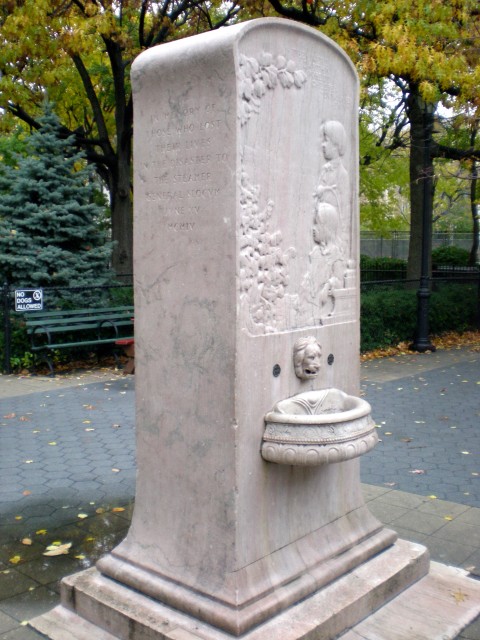
Dedicated in 1906, this fountain serves as a reminder of those who died aboard the excursion steamerGeneral Slocum on June 15, 1904. Prior to September 11, 2001, the burning of the General Slocum had the highest death toll of any disaster in New York City history. The incident claimed an irreplaceable part of the Lower East Side community once known as Little Germany and remains the worst inland-waters, peacetime tragedy in the nation’s history.
The Slocum was a triple-decker wooden ship built in 1891, named after General Henry Warner Slocum (1827-1894) who commanded the extreme right line of the Union Army at Gettysburg and represented the City of Brooklyn in Congress for three terms. It was one of nearly a dozen excursion steamers that traveled around New York waterways, enabling working class people to escape the city even if just for a few hours. On its final voyage, the Slocum was to vary its normal two trips to the Rockaways in order to bring a large party to Locust Grove on Long Island.
The approximately 1,300 passengers and 35 member crew included the congregation of St. Mark’s Evangelical Lutheran Church, located on 6th Street near 2nd Avenue, who were en route to their seventeenth annual picnic. As it was a weekday, the majority of the German immigrants and people of German descent who comprised the group were women and children. This was also true for the other passengers who hailed from all over the New York area.
Twenty minutes after the ship departed the Third Street pier on the East River, it entered the ever treacherous junction of the East River, New York Harbor and Long Island Sound. There it was overtaken not by the current but by flames and Captain William Van Schaik docked, shortly after 10AM, at North Brother Island, near Riker’s Island. Of the more than 1,000 people who died, many were buried in the Lutheran cemetery in Middle Village, Queens, where a monument was erected in 1905 to honor the unidentified dead. The disaster was the fatal end of a ship with a history of accidents and was attributed to inadequate safety precautions and the negligence of the Captain.
The Slocum Memorial Fountain by sculptor Bruno Louis Zimm was donated by the Sympathy Society of German Ladies and installed in Tompkins Square Park, a central feature of the neighborhood. The nine foot upright stele is made of pink Tennessee marble with a low relief of two children looking seaward as well as a lionhead spout. Zimm, who was a member of the Woodstock Artists Colony, also designed a similar fountain, the Women’s Health Protective Monument, located at 116th Street and Riverside Drive, and the frieze on the pediment of the Fine Arts building in San Francisco.
via NYC Parks
| internal | gDoc TBC |
| internal | NYC Parks page |
| internal | CultureNow article |
| internal | New York History |
| internal | New York Public Library |
| internal | General Slocum |

The words written on the manhole cover, “In direct line with another and the next,” refers to the grid pattern of New York City’s streets. Instead of a precious sculpture set on a pedestal, Lawrence Weiner’s sculpture is walked upon by tourists and residents of the city. According to the Public Art Fund’s press release, the work “also refers to the odd democracy of the New York City. While a city of vast extremes, the rich and poor, powerful and disenfranchised still all wait for the same ‘don’t walk’ signs to change when crossing the street. Standing on line, riding the subway, walking down the street, New Yorkers are always ‘in direct line with another and the next.'”
They can be found in 19 locations below Union Square.
Weiner is one of the central figures in the formation of conceptual art in the 1960s. His work often takes the form of typographic texts. He is regarded as a founding figure of Postminimalism’s Conceptual arm, which includes artists like Douglas Huebler, Robert Barry, Joseph Kosuth, and Sol LeWitt.
edited from CultureNOW
| internal | gDoc TBC |
| internal | Public Art Fund |
| internal | CultureNow article |

The Electric Circus, a nightclub on 19-25 St. Marks Place, was a wild and experimental hub for 1960s club culture. When it opened in 1967, owners Jerry Brandt and Stanton J. Freeman invited club goers to “play games, dress as you like, dance, sit, think, tune in and turn on.”
The Electric Circus became known for its light shows, music, and experimental theater. Trapeze artists and flame throwing jugglers performed between musical sets while strobe lights flashed. This easy going and accepting atmosphere greatly influenced the discos that came after it.
Iconic bands such as The Velvet Underground, The Grateful Dead, Blue Öyster Cult, the Allman Brothers Band, and Sly & the Family Stone regularly played the venue. The Circus became the site of Andy Warhol’s and director Paul Morrissey’s Exploding Plastic Inevitable, a light and music show starring the Velvet Underground. While the Velvets played their experimental compositions, light effects, projected photographs and movies shone onto the band.
By 1970, the free-loving bohemian lifestyle of the late 60s was losing appeal and the club began slowly losing popularity. The fatal blow to the venue was when a small bomb exploded on the dance floor in 1970. Fifteen people were injured in the explosion. While many believed that a member of the Black Panthers planted it there, the owners said that they didn’t believe the story being that they had good relations with the Panthers.
Unfortunately, the club never recovered from the attack and the reputation it adapted after the incident. A year later, the Electric Circus finally closed.
| internal | gDoc TBC |
| internal | Wikipedia |
| internal | Art Nerd article |
| internal | A Look Back at the Electric Circus, the Greatest Show on St. Marks Place |
| internal | The Exploding Plastic Inevitable |
| internal | EPI footage |
| link | Street View |
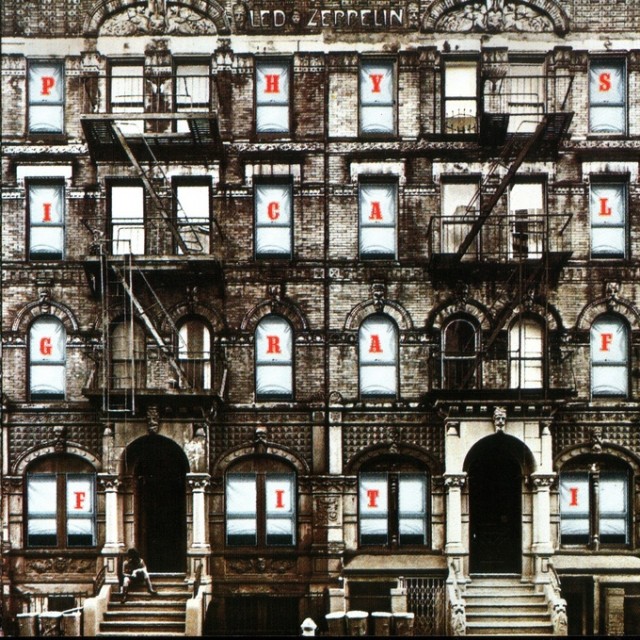
When graphic artist Peter Corriston was designing the cover art for Led Zeppelin’s 1975 album “Physical Graffiti,” the symmetry, fire escapes, and many windows of 96 and 98 St. Marks Place were exactly what he was looking for. When the buildings were photographed, Corriston had to crop out one of the floors–making both the buildings four storeys instead of their actual five–in order to fit them on the cover. There have been various theories as to who the man sitting on the left stoop is, with some saying that it is a tenant who lived in the building, and others saying that it is actually John Bonham, the band’s drummer.
Only a few years after the release of “Physical Graffiti.” the building also appeared in the Rolling Stones’ 1981 “Waiting On a Friend” music video. Corriston also designed the cover art for the Rolling Stones album “Tattoo You,” the album on which “Waiting On a Friend” appears.
New York City in the 1970’s and 1980’s was known to attract English musicians like the Rolling Stones and Led Zeppelin and offered the perfect atmosphere for parties and socializing. Rolling Stones singer Mick Jagger became a central character in the New York socialite scene and would often be seen at Studio 54 with Andy Warhol and Roy Halston.
St. Mark’s Place is steeped in rock ‘n’ roll history, with many of its buildings serving as sites of various nightclubs–such as Andy Warhol’s Electric Circus where the Velvet Underground was the house band–and punk clothing shops visited by Debbie Harry and Joey Ramone.
| internal | gDoc TBC |
| internal | On the Stoop of Rock 'n' Roll History |
| internal | Classic Album Covers |
| internal | St. Marks: One of Rock's Most Memorable Streets |
| internal | Album Cover |
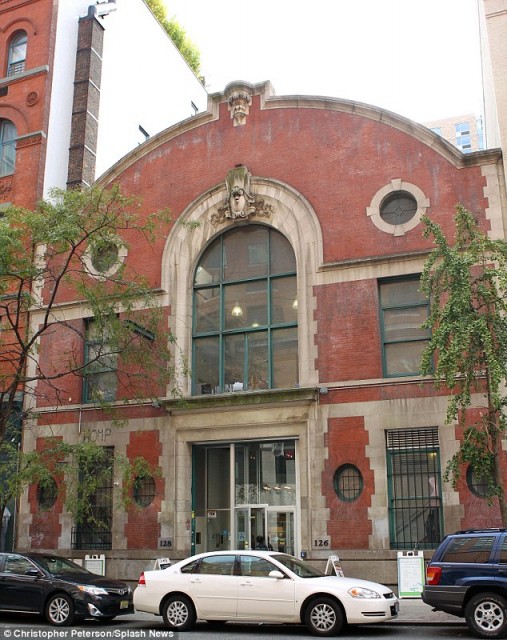
The 11,800-square-foot Beaux Arts building at 126 East 13th Street, originally built in 1904, housed the Van Tassell & Kearney Auction Mart, one of the city‘s top sellers of horses and horse-drawn carriages. During World War II, the building was used as an assembly-line training center for women. After the war, it was used as a machine shop, and would continue to operate as such until the late 1970s, when famed sculptor Frank Stella converted the building to an art studio. The building served as Stella’s studio from 1978-2005.
After a 6-year campaign to save the building, it finally became an official City landmark in 2012.
Today, 126-128 East 13th Street houses the Peridance Capezio Center.
edited from Real Deal
| internal | gDoc TBC |
| internal | Greenwich Village Society for Historic Preservation |
| internal | Van Tassell and Kearney Horse Auction Mart |
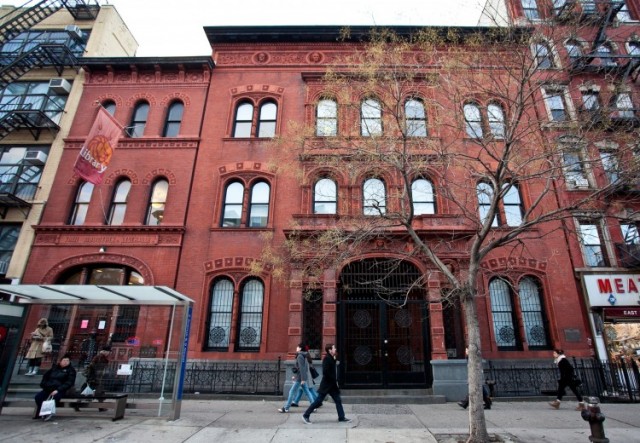
The Ottendorfer Branch of the New York Public Library opened in 1884 as New York City’s first free public library. Designed by German-born architect William Schickel, this landmark building combines Queen Anne and neo-Italian Renaissance styles with an exterior ornamented by innovative terracotta putti. The branch was a gift of Oswald Ottendorfer, owner of the New-Yorker Staats-Zeitung newspaper. At the time, the neighborhood was called Kleindeutschland (“Little Germany”) and had a population of over 150,000 people of German descent. Ottendorfer wished to provide this community with books to cultivate their minds and assist assimilation into American culture. Half of the 8,000 original books were in German with the other half in English. In this tradition, the branch continues to reflect its community and remains a vital educational and cultural resource for the East Village.
The building, which is a designated New York City landmark, has been completely renovated through the Library’s Adopt-a-Branch program, through which private donors join public funders to restore branch libraries. While the original Ottendorfer Branch was designed as a bilingual library to serve the German community, the restored library can now better serve its multilingual community and provide an increased level of accessibility to all people.
| internal | gDoc TBC |
| internal | Wikipedia |
| internal | NYPL |
| internal | History of library in New York |
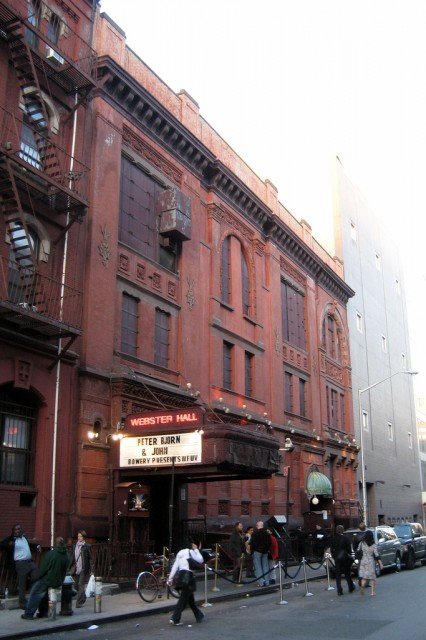
From the time of its construction in 1886, Webster Hall served as a performance space where East Village residents could come together and share ideas. Designed by architect Charles Rentz, Webster Hall was commissioned by Polish-born cigar maker Charles Goldstein as a public rental hall.
Throughout the 1910s, the venue was a space for concerts, labor union rallies, and socialist gatherings. By the 1920s, however, Webster Hall was no longer the center for left-leaning political movements, but for eccentric masquerade balls. Webster Hall’s reputation for parties continued to grow even as Prohibition hit, and was soon transformed into a speakeasy. When Prohibition was repealed, the venue hosted a large and outlandish ball called The Return of John Barleycorn on New Year’s Eve of 1933 in celebration.
In 1953 the building was purchased by RCA Records and rebuilt and became RCA’s East Coast recording studio. On February 2, 1962, Bob Dylan was recorded for the first time ever in Webster Hall, playing harmonica on the title track of Harry Belafonte’s Midnight Special.
On May 1, 1980, the Hall became The Ritz nightclub, which would eventually go on to become the leading rock venue in NYC through the 80’s. In 1989, nightclub and venue operators the Ballinger Brothers took control of the venue, restored the building, and returned it to its original name.
In 2007, Webster Hall became a New York City landmark.
| internal | gDoc TBC |
| internal | Webster Hall Timeline |
| internal | Wikipedia |
| internal | The Ritz |
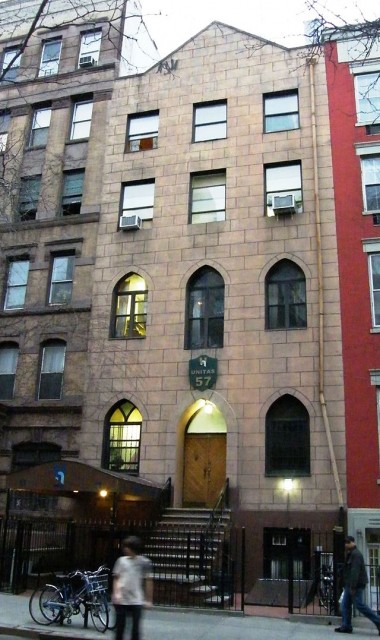
Located in the basement of the Holy Cross Polish National Church, Club 57 was the hang out of Madonna, Joey Arias, Fab Five Freddy, Kenny Scharf, The B-52s, Basquiat, Futura and Keith Haring, who curated shows here. Theme parties, day glo, Monster Movies, and black lights could be found inside. Haring performed his neo-dada poems inside of a giant television, and exhibited Black Light shows, that were combined with the clubs dancing, drugs and orgiastic sex.
Magnuson herself described Club 57 as being home to “pointy-toed hipsters, girls in rockabilly petticoats, spandex pants, and thrift-store stiletto heels…suburban refugees who had run away from home to find a new family…who liked the things we liked – Devo, Duchamp, and William S. Burroughs – and (more important) hated the things we hated – disco, Diane von Fürstenberg, and The Waltons.”
As all the artist kids got more and more popular, they moved on to more expensive venues, until the club was finally closed in 1983.
| internal | gDoc TBC |
| internal | East Village Preservation Society: Club 57 |
| internal | Wikipedia |
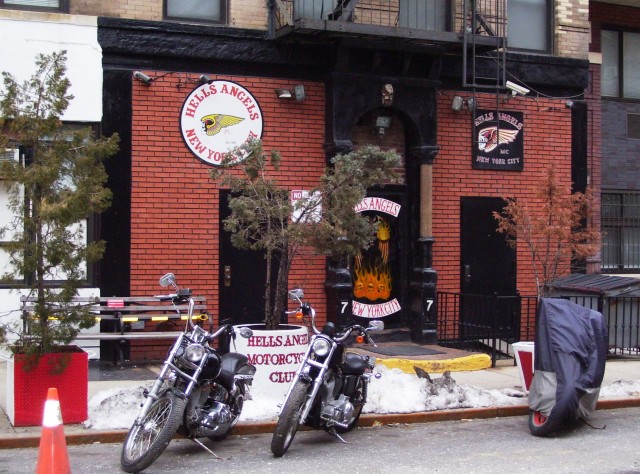
77 has been standing resolute since 1899, but the Hells Angels didn’t move here until 1969. The first floor became the clubhouse and the upper five floors contained residential apartments, the majority of which were/are occupied by members.
| internal | gDoc TBC |
| internal | Bowery Boogie: Hells Angels HQ |
| internal | Hells Angels history |
| internal |

The New York City Marble Cemetery on 60 East 2nd Street was begun in 1831 and was the second non-sectarian burial ground in the City opened to the public. The cemetery was started shortly after the New York Marble Cemetery, one block away, had begun.
It was laid out on some land belonging to Samuel Cowdrey, a vault owner in the other cemetery. Once again, Perkins Nichols contracted for the construction of the vaults of Tuckahoe marble. The first vaults were ready by the summer of 1831. The new organization received its own act of incorporation on April 26, 1832. Over the next three years the corporation acquired first the land in which the vaults were situated, and then adjoining lots, until it reached its present limits in 1835. The grounds now contain 258 vaults.
When opened, it was considered a fashionable burial place, and the use of monuments and markers was permitted there to signalize the locations of the family vaults. It was laid out with long parallel walks between which are narrow strips of ground punctuated by the square marble vault slabs.
The most important person buried in this cemetery was ex-President James Monroe, who had moved to New York in 1830, after the death of his wife, to live with his son-in-law, Samuel Gouverneur. Gouverneur owned a vault in the cemetery, and when Monroe died on July 4, 1831, he became one of the first to be buried here. The interment ceremonies were carried out with much pomp and military pageantry, which served to increase greatly the prestige of the cemetery. In 1857, however, a number of Virginians residing in New York decided to erect a monument over Monroe’s vault. This move prompted the Virginia Legislature to pass a resolution to have the ex-President’s remains returned to Virginia. The Gouverneur family agreed, and on July 2, 1858, Monroe’s body was removed.
Another nationally known figure buried here is John Lloyd Stephens, who pioneered archeological research in the Mayan country of Mexico in the Nineteenth Century; his vault is marked by a Mayan glyph designed by his celebrated collaborator, Frederick Catherwood.
The cemetery also holds the remains of Dutch dominies, the oldest white men’s bones interred on the island of Manhattan.
edited from New York City Marble Cemetery
| internal | gDoc TBC |
| internal | Wikipedia |
| internal | Cemetery website |
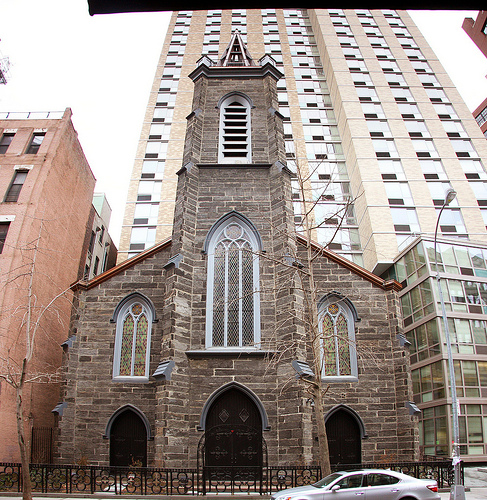
Though St. Ann’s Church at 122 East 12th Street was once among the wealthiest congregations in the city in the late 19th century, it is now merely a hollow facade.
Due to changing demographics, the once thriving church was forced to close and was bought by a building developer in 2005. Though many petitioned for it to be landmarked, their efforts went unnoticed. It was soon announced that the site would home the new New York University dormitory buildings, much to the community’s distaste. To make room for the new dorm complex, the entire church–expect for the facade–was demolished. What remains today is a wall of stone and a mock steeple dating back to the 1840s.
According to the AIA Guide to New York City, the attempt to preserve the structure was futile. “No connection is made, or even attempted, between the old church and the 26-story hulk,” it said. “The effect is of a majestic elk, shot and stuffed.”
| internal | gDoc TBC |
| internal | Art Nerd Article |
| internal | Wikipedia |
| internal | Scouting New York |
| internal | The Travesty of St. Ann's Church |